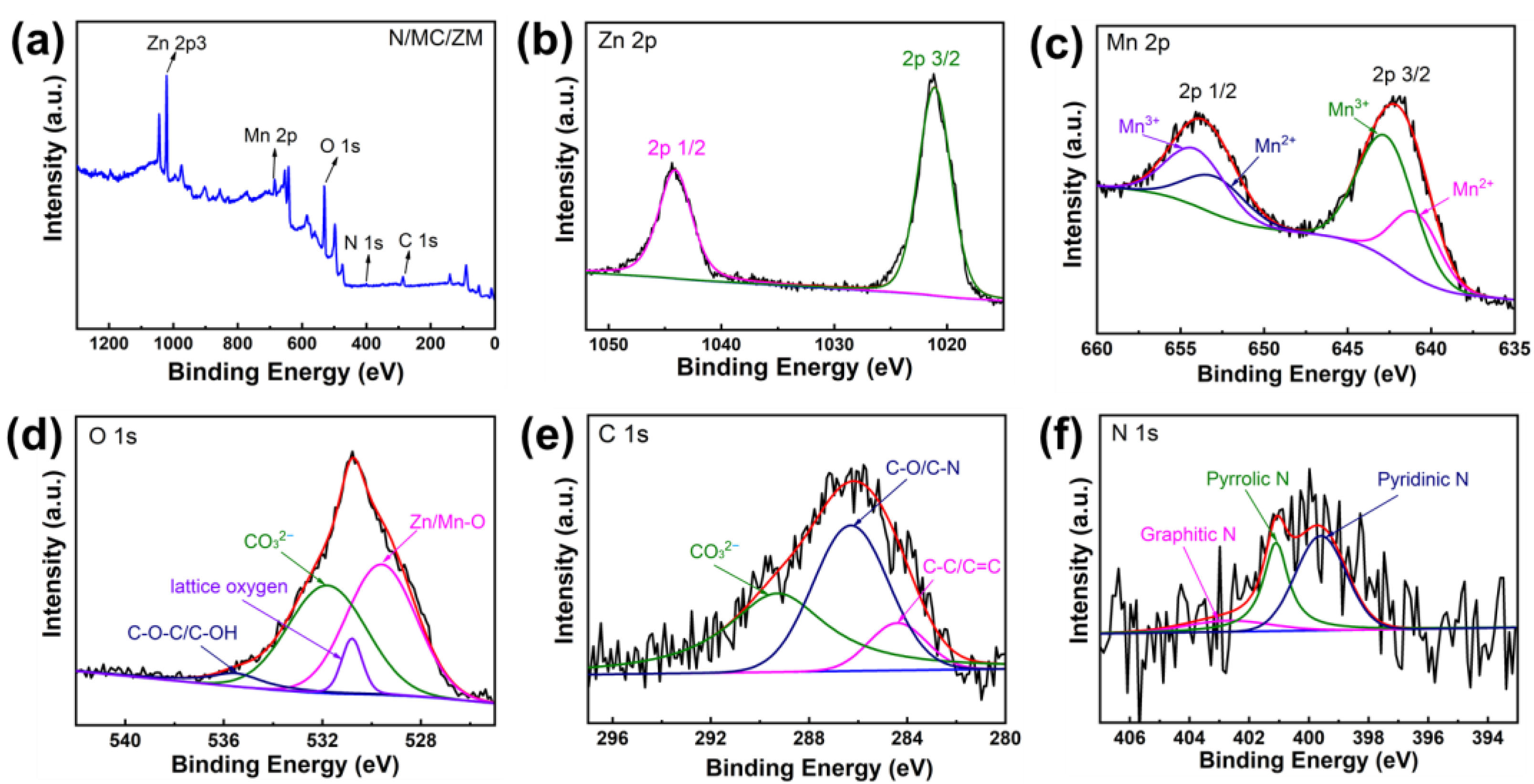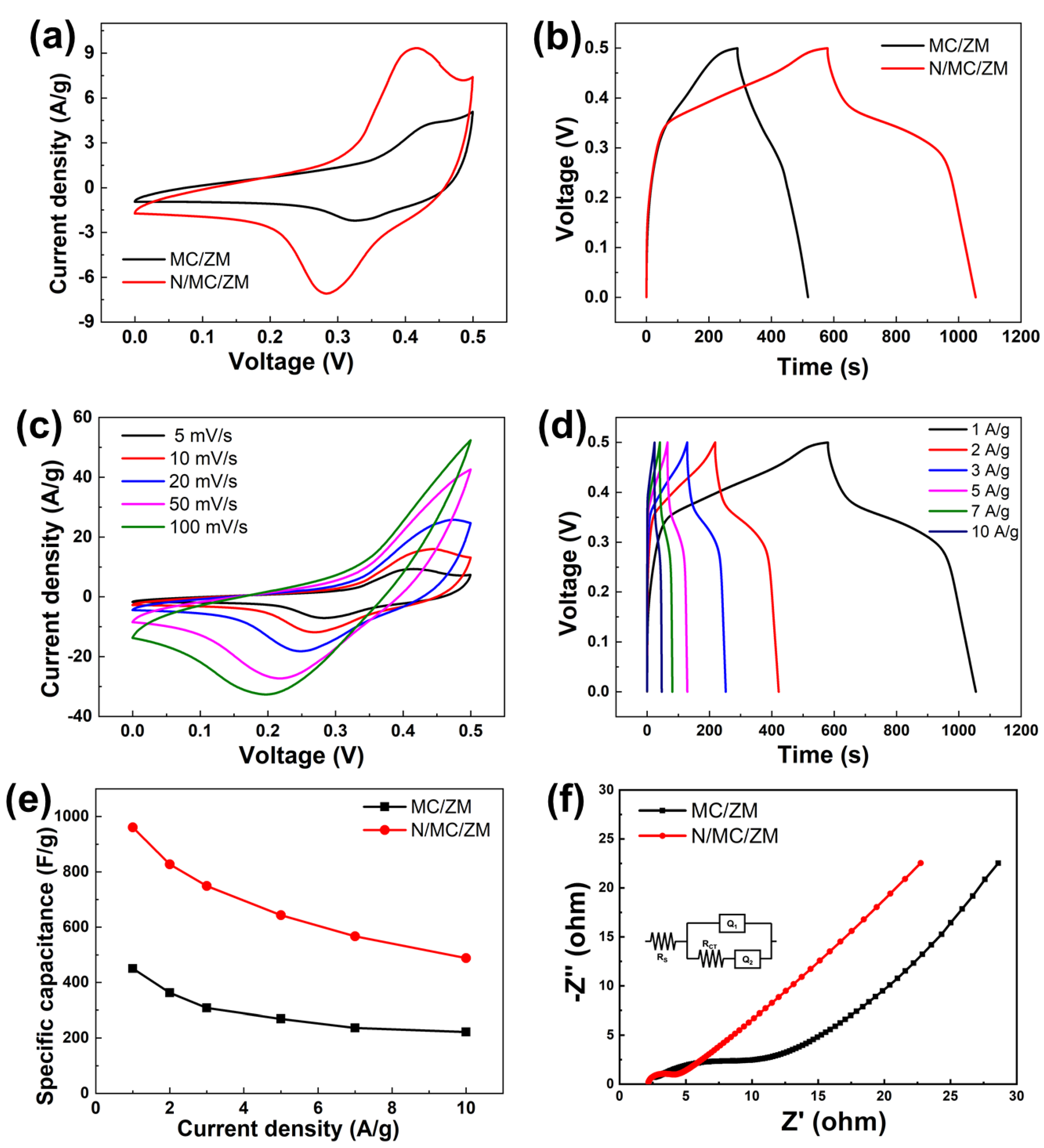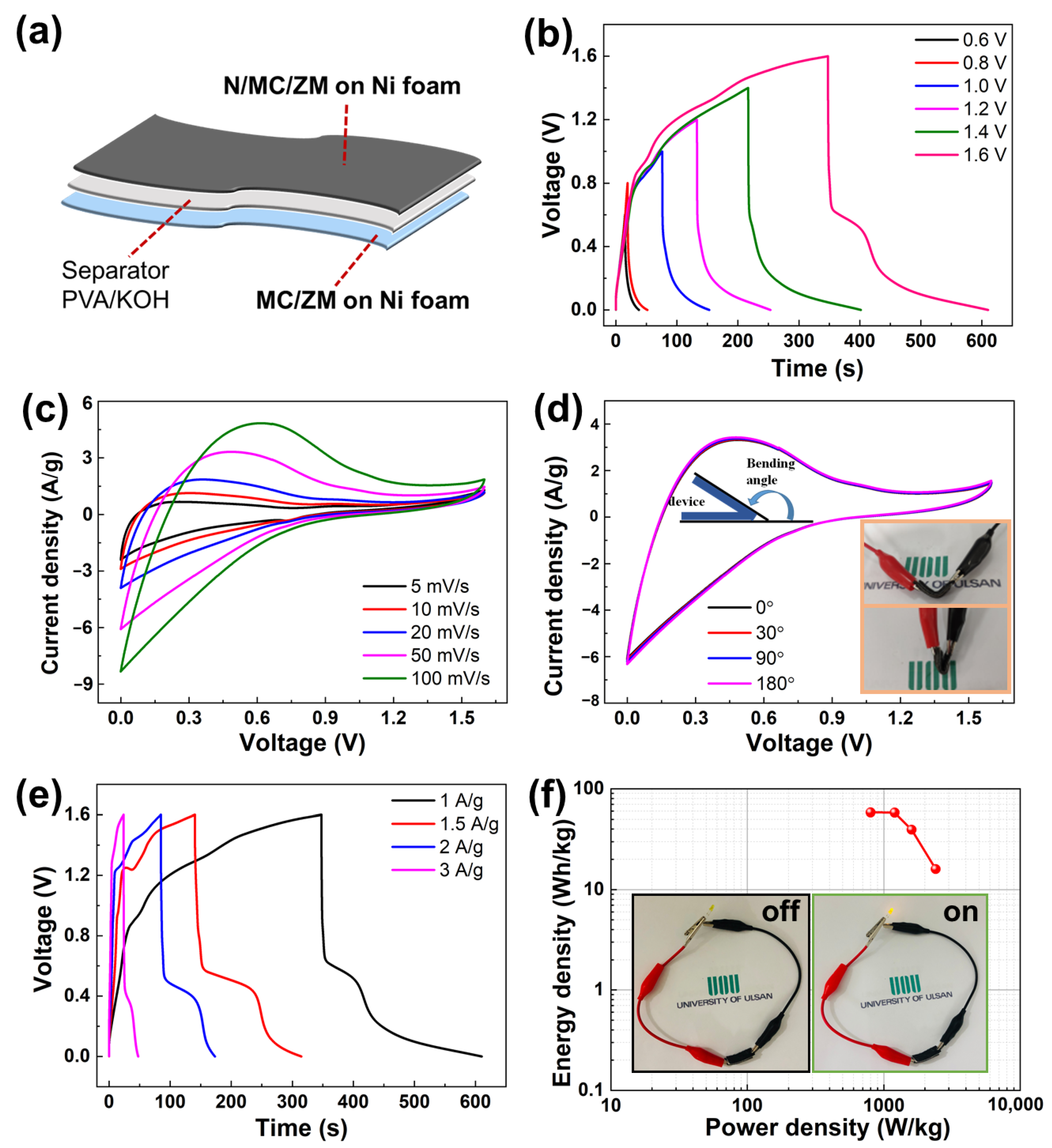Facile Synthesis of Nitrogen-Doped Graphene Quantum Dots/MnCO3/ZnMn2O4 on Ni Foam Composites for High-Performance Supercapacitor Electrodes
Abstract
1. Introduction
2. Materials and Methods
2.1. Synthesis of N-GQDs
2.2. Preparation of MnCO3/ZnMn2O4 and N-GQDs/MnCO3/ZnMn2O4
2.3. Characterizations
2.4. Electrochemical Measurements
3. Results and Discussion
4. Conclusions
Supplementary Materials
Author Contributions
Funding
Institutional Review Board Statement
Informed Consent Statement
Data Availability Statement
Acknowledgments
Conflicts of Interest
References
- Kumar, S.; Saeed, G.; Zhu, L.; Huic, K.N.; Kim, N.H.; Lee, J.H. 0D to 3D carbon-based networks combined with pseudocapacitive electrode material for high energy density supercapacitor: A review. Chem. Eng. J. 2021, 403, 126352. [Google Scholar] [CrossRef]
- Najib, S.; Erdem, E. Current progress achieved in novel materials for supercapacitor electrodes: Mini review. Nanoscale Adv. 2019, 1, 2817–2827. [Google Scholar] [CrossRef]
- Anil Kumar, Y.; Yadav, A.A.; Al-Asbahi, B.A.; Kang, S.-W.; Moniruzzaman, M. Sulfur Nanoparticle-Decorated Nickel Cobalt Sulfide Hetero-Nanostructures with Enhanced Energy Storage for High-Performance Supercapacitors. Molecules 2022, 27, 7458. [Google Scholar] [CrossRef] [PubMed]
- Yadav, A.A.; Hunge, Y.M.; Ko, S.; Kang, S.-W. Chemically Synthesized Iron-Oxide-Based Pure Negative Electrode for Solid-State Asymmetric Supercapacitor Devices. Materials 2022, 15, 6133. [Google Scholar] [CrossRef]
- Chodankar, N.R.; Pham, H.D.; Nanjundan, A.K.; Fernando, J.F.S. True meaning of pseudocapacitors and their performance metrics: Asymmetric versus hybrid supercapacitors. Small 2020, 16, 2002806. [Google Scholar] [CrossRef]
- Tang, S.; Zhu, B.; Shi, X.; Wu, J.; Meng, X. General Controlled Sulfidation toward Achieving Novel Nanosheet-Built Porous Square-FeCo2S4-Tube Arrays for High-Performance Asymmetric All-Solid-State Pseudocapacitors. Adv. Energy Mater. 2017, 7, 1601985. [Google Scholar] [CrossRef]
- Barai, H.R.; Lopa, N.S.; Ahmed, F.; Khan, N.A.; Ansari, S.A.; Joo, S.W.; Rahman, M.M. Synthesis of Cu-Doped Mn3O4@ Mn-Doped CuO Nanostructured Electrode Materials by a Solution Process for High-Performance Electrochemical Pseudocapacitors. ACS Omega 2020, 5, 22356–22366. [Google Scholar] [CrossRef] [PubMed]
- Li, G.; Chang, Z.; Lim, T.; Ma, L.; Wang, K. Hierarchical Mn-Co sulfide nanosheets on nickel foam by electrochemical co-deposition for high-performance pseudocapacitors. Ionics 2019, 25, 3885–3895. [Google Scholar] [CrossRef]
- Wang, H.Y.; Li, D.G.; Zhu, H.L.; Qi, Y.X.; Lun, N.; Bai, Y.J. Mn3O4/Ni(OH)2 nanocomposite as an applicable electrode material for pseudocapacitors. Electrochim. Acta 2017, 249, 155–165. [Google Scholar] [CrossRef]
- Sekhar, S.C.; Nagaraju, G.; Yu, J.S. Ant-cave structured MnCO3/Mn3O4 microcubes by biopolymer-assisted facile synthesis for high-performance pseudocapacitors. Appl. Surf. Sci. 2018, 435, 398–405. [Google Scholar] [CrossRef]
- Karuppaiah, M.; Sakthivel, P.; Asaithambi, S.; Murugan, R.; Ravi, G. Formation of one dimensional nanorods with microsphere of MnCO3 using Ag as dopant to enhance the performance of pseudocapacitors. Mater. Chem. Phys. 2019, 228, 1–8. [Google Scholar] [CrossRef]
- Himasree, P.; Durga, I.K.; Krishna, T.N.V.; Rao, S.S.; Gopi, C.V.V.M.; Revathi, S.; Prabakar, K.; Kim, H.J. One-step hydrothermal synthesis of CuS@MnS on Ni foam for high performance supercapacitor electrode material. Electrochim. Acta 2019, 305, 467–473. [Google Scholar] [CrossRef]
- Wu, H.; Lou, Z.; Yang, H.; Shen, G.Z. A flexible spiral-type supercapacitor based on ZnCo2O4 nanorod electrodes. Nanoscale 2015, 7, 1921–1926. [Google Scholar] [CrossRef]
- Yuan, C.Z.; Li, J.Y.; Hou, L.R.; Zhang, X.G.; Shen, L.F.; Lou, X.W. Ultrathin Mesoporous NiCo2O4 Nanosheets Supported on Ni Foam as Advanced Electrodes for Supercapacitors. Adv. Funct. Mater. 2012, 22, 4592–4597. [Google Scholar] [CrossRef]
- Kim, J.; Lee, H.; Kim, Y.; Kimi, W. Fabrication of free-standing ZnMn2O4 mesoscale tubular arrays for lithium-ion anodes with highly reversible lithium storage properties. ACS Appl. Mater. Interfaces 2013, 5, 11321–11328. [Google Scholar] [CrossRef] [PubMed]
- Dar, M.A.; Dinagaran, S.; Govindarajan, D.; Ahamed, S.R.; Habib, F.; Siva, C.; Moholkar, A.V.; Ahmad, Z.; Yatoo, M.A. Snx-0MnxS nanomaterial based electrodes for future-generation supercapacitor and data storage devices. J. Alloys Compd. 2023, 958, 170523. [Google Scholar] [CrossRef]
- Gopi, C.V.V.M.; Venkata-Haritha, M.; Kim, S.K.; Prabakar, K.; Kim, H.J. Flower-like ZnO MnCo2O4 nanosheet structures on nickel foam as novel electrode material for high-performance supercapacitors. RSC Adv. 2016, 6, 102961–102967. [Google Scholar] [CrossRef]
- Reddy, A.E.; Anitha, T.; Gopi, C.V.V.M.; Srinivasa, R.S.; Thulasi-Varma, C.V.; Punnoose, D.; Kim, H.-J. Fabrication of a snail shell-like structured MnO2@CoNiO2 composite electrode for high performance supercapacitors. RSC Adv. 2017, 7, 12301–12308. [Google Scholar] [CrossRef]
- Tang, X.; Jia, R.; Zhai, T.; Xia, H. Hierarchical Fe3O4@Fe2O3 core–shell nanorod arrays as high-performance anodes for asymmetric supercapacitors. ACS Appl. Mater. Interfaces 2015, 7, 27518–27525. [Google Scholar] [CrossRef] [PubMed]
- Hu, X.W.; Liu, S.; Qu, B.T.; You, X.Z. Starfish-shaped Co3O4/ZnFe2O4 Hollow Nanocomposite: Synthesis, Supercapacity, and Magnetic Properties. ACS Appl. Mater. Interfaces 2015, 7, 9972–9981. [Google Scholar] [CrossRef]
- Kadam, V.S.; Jagtap, C.V.; Lokhande, P.E.; Bulakhe, R.N.; Kang, S.-W.; Yadav, A.A.; Pathan, H.M. One-step deposition of nanostructured Ni(OH)2/rGO for supercapacitor applications. J. Mater. Sci. Mater. Electron. 2023, 34, 1083. [Google Scholar] [CrossRef]
- Wang, S.; Shen, J.; Wang, Q.; Fan, Y.; Li, L.; Zhang, K.; Yang, L.; Zhang, W.; Wang, X. High-Performance Layer-by-Layer Self-Assembly PANI/GQD-rGO/CFC Electrodes for a Flexible Solid-State Supercapacitor by a Facile Spraying Technique. ACS Appl. Energy Mater. 2019, 2, 1077–1085. [Google Scholar] [CrossRef]
- Rahimpour, K.; Teimuri-Mofrad, R. Novel hybrid supercapacitor based on ferrocenyl modified graphene quantum dot and polypyrrole nanocomposite. Electrochim. Acta 2020, 345, 136207. [Google Scholar] [CrossRef]
- Ashourdan, M.; Semnani, A.; Hasanpour, F.; Moosavifard, S.E. Synthesis of CuMnO2/graphene quantum dot nanocomposites as novel electrode materials for high performance supercapacitors. J. Energy Storage 2021, 36, 102449. [Google Scholar] [CrossRef]
- Keyang, H.; Ruiyi, L.; Zaijun, L.; Yongqiang, Y. Controllable Synthesis of Superparamagnetic NiCo-Graphene Quantum Dot-Graphene Composite with Excellent Dispersion for High Performance Magnetic Field-Controlled Electrochemical Flow Hybrid Supercapacitor. Electrochim. Acta 2020, 353, 136524. [Google Scholar] [CrossRef]
- Li, Z.; Liu, X.; Wang, L.; Bu, F.; Wei, J.; Pan, D.; Wu, M. Hierarchical 3D all-carbon composite structure modified with N-doped graphene quantum dots for high-performance flexible supercapacitors. Small 2018, 14, 1801498. [Google Scholar] [CrossRef] [PubMed]
- Zahir, N.; Magri, P.; Luo, W.; Gaumet, J.J.; Pierrat, P. Recent Advances on Graphene Quantum Dots for Electrochemical Energy Storage Devices. Energy Environ. Mater. 2021, 5, 201–214. [Google Scholar] [CrossRef]
- Li, Z.; Wei, J.; Ren, J.; Wu, X.; Wang, L.; Pan, D.; Wu, M. Hierarchical construction of high-performance all-carbon flexible fiber supercapacitors with graphene hydrogel and nitrogen-doped graphene quantum dots. Carbon N. Y. 2019, 154, 410–419. [Google Scholar] [CrossRef]
- Wu, H.; Guo, Z.S.; Li, M.; Hu, G.H.; Tang, T.; Wen, J.F.; Li, X.Y.; Huang, H.F. Enhanced pseudocapacitive performance of MoS2 by introduction of both N-GQDs and HCNT for flexible supercapacitors. Electrochim. Acta 2021, 370, 137758. [Google Scholar] [CrossRef]
- Abdollahifar, M.; Huang, S.S.; Lin, Y.H.; Lin, Y.C.; Shih, B.Y.; Sheu, H.S.; Liao, Y.F.; Wu, N.L. High-performance carbon-coated ZnMn2O4 nanocrystallite supercapacitors with tailored microstructures enabled by a novel solution combustion method. J. Power Sources 2018, 378, 90–97. [Google Scholar] [CrossRef]
- Sannasi, V.; Subbian, K. A facile synthesis of ZnMn2O4/Mn2O3 composite nanostructures for supercapacitor applications. Ceram. Int. 2021, 47, 12300–12309. [Google Scholar] [CrossRef]
- Nagamuthu, S.; Vijayakumar, S.; Lee, S.-H.; Ryu, K.-S. Hybrid supercapacitor devices based on MnCo2O4 as the positive electrode and FeMn2O4 as the negative electrode. Appl. Surf. Sci. 2016, 390, 202–208. [Google Scholar] [CrossRef]
- Jayakumar, A.; Antony, R.P.; Wang, R.; Lee, J.M. MOF-Derived Hollow Cage NixCo3−xO4 and Their Synergy with Graphene for Outstanding Supercapacitors. Small 2017, 13, 1603102. [Google Scholar] [CrossRef]
- Chen, C.; Yu, W.; Liu, T.; Cao, S.; Tsang, Y. Graphene oxide/WS2/Mg-doped ZnO nanocomposites for solar-light catalytic and anti-bacterial applications. Sol. Energy Mater. Sol. Cells 2017, 160, 43–53. [Google Scholar] [CrossRef]
- Chen, C.; Liu, X.; Fang, Q.; Chen, X.; Liu, T.; Zhang, M. Self-assembly synthesis of CuO/ZnO hollow microspheres and their photocatalytic performance under natural sunlight. Vacuum 2020, 174, 109198. [Google Scholar] [CrossRef]
- Duan, J.; Zhu, C.; Du, Y.; Wu, Y.; Chen, Z.; Le, L.; Zhu, H.; Zhu, Z. Synthesis of N-doped carbon-coated Zn–Sn mixed oxide cubes/graphene composite with enhanced lithium storage properties. J. Mater. Sci. 2017, 52, 10470–10479. [Google Scholar]
- Zhou, W.; Lei, S.; Sun, S.; Ou, X.; Fu, Q.; Xu, Y.; Xiao, Y.; Cheng, B. From weed to multi-heteroatom-doped honeycomb-like porous carbon for advanced supercapacitors: A gelatinization-controlled one-step carbonization. J. Power Sources 2018, 402, 203–212. [Google Scholar] [CrossRef]
- Li, Z.; Bu, F.; Wei, J.; Yao, W.; Wang, L.; Chen, Z.; Pan, D.; Wu, M. Boosting the energy storage densities of supercapacitors by incorporating N-doped graphene quantum dots into cubic porous carbon. Nanoscale 2018, 10, 22871–22883. [Google Scholar] [CrossRef] [PubMed]
- Yang, J.; Jo, M.R.; Kang, M.; Huh, Y.S.; Jung, H.; Kang, Y.M. Rapid and controlled synthesis of nitrogen doped reduced graphene oxide using microwave-assisted hydrothermal reaction for high power-density supercapacitors. Carbon 2014, 73, 106–113. [Google Scholar] [CrossRef]
- Hussain, S.K.; Yu, J.S. Cobalt-doped zinc manganese oxide porous nanocubes with controlled morphology as positive electrode for hybrid supercapacitors. Chem. Eng. J. 2019, 361, 1030–1042. [Google Scholar] [CrossRef]
- Sim, C.-K.; Razali, S.A.; Majid, S.R.; Mahmood, N.Z. Synthesis and Characterization of Ternary Mesoporous Carbon/ZnMn2O4 for Supercapacitor Application. J. Electron. Mater. 2019, 49, 1024–1035. [Google Scholar] [CrossRef]
- Bhagwan, J.; Kumar, N.; Yadav, K.L.; Sharma, Y. Probing the Electrical Properties and Energy Storage Performance of Electrospun ZnMn2O4 Nanofibers. Solid State Ion. 2018, 321, 75–82. [Google Scholar] [CrossRef]
- Barkhordari, H.; Heydari, H.; Nosrati, A.; Mohammadi, J. Facile Synthesis of ZnMn2O4 Nanosheets via Cathodic Electrodeposition: Characterization and Supercapacitor Behavior Studies. Ionics 2019, 25, 275–285. [Google Scholar] [CrossRef]
- Ameri, B.; Davarani, S.S.H.; Moazami, H.R.; Darjazi, H. Cathodic electrosynthesis of ZnMn2O4/Mn3O4 composite nanostructures for high performance supercapacitor applications. J. Alloys Compd. 2017, 720, 408–416. [Google Scholar] [CrossRef]
- Fang, Q.; Chen, C.; Yang, Z.; Chen, X.; Chen, X.; Liu, T. Synthetization and Electrochemical Performance of Pomegranate-like ZnMn2O4 Porous Microspheres. J. Alloys Compd. 2020, 826, 154084. [Google Scholar] [CrossRef]
- Huang, T.; Zhao, C.; Qiu, Z.; Luo, J.; Hu, Z. Hierarchical porous ZnMn2O4 synthesized by the sucrose-assisted combustion method for high-rate supercapacitors. Ionics 2017, 23, 139–146. [Google Scholar] [CrossRef]
- Ansari, S.A.; Parveen, N.; Kotb, H.M.; Alshoaibi, A. Hydrothermally derived three-dimensional porous hollow double-walled Mn2O3 nanocubes as superior electrode materials for supercapacitor applications. Electrochim. Acta 2020, 355, 136783. [Google Scholar] [CrossRef]
- Pech, O.; Maesiri, S. Electrochemical performances of electrospun carbon nanofibers, interconnected carbon nanofibers, and carbon-manganese oxide composite nanofibers. J. Alloys. Compd. 2019, 781, 541–552. [Google Scholar] [CrossRef]
- Zhang, X.; Zhang, F.; Wei, D.; Cai, Z.; Song, Y.; Wang, X. Design and synthesis of K-doped tremella-like δ-MnO2 for high-performance supercapacitor. J. Energy Storage 2023, 72, 108468. [Google Scholar] [CrossRef]
- Gupta, M.K.; Kumar, Y.; Sonnathi, N.; Sharma, S.K. Hydrothermally grown zinc oxide nanostructures@ carbon composites for supercapacitor application. Phys. Status Solidi (A) Appl. Mater. Sci. 2023, 220, 2200451. [Google Scholar] [CrossRef]
- Khan, K.; Shah, M.Z.U.; Aziz, U.; Hayat, K.; Sajjad, M.; Ahmad, I.; Ahmad, S.A.; Shah, S.K.; Shah, A. Development of 1.6 V hybrid supercapacitor based on ZnO nanorods/MnO2 nanowires for next-generation electrochemical energy storage. J. Electroanal. Chem. 2022, 922, 116753. [Google Scholar] [CrossRef]
- Humayun, H.; Begum, B.; Bilal, S.; Shah, A.u.H.A.; Röse, P. Polyindole Embedded Nickel/Zinc Oxide Nanocomposites for High-Performance Energy Storage Applications. Nanomaterials 2023, 13, 618. [Google Scholar] [CrossRef] [PubMed]







| Material | Electrolyte | Specific Capacitance | Ref. |
| ZnMn2O4 Nanofibers | 1 M Na2SO4 | 240 F·g−1 @ 1 A·g−1 | [42] |
| ZnMn2O4 Nanosheets | 0.5 M Na2SO4 | 456.8 F·g−1 @ 1 A·g−1 | [43] |
| ZnMn2O4/Mn3O4 composite | 2 M KOH | 380 F·g−1 @ 0.5 A·g−1 | [31] |
| ZnMn2O4/Mn3O4 composite | 1 M Na2SO4 | 321 F·g−1 @ 1 mV·s−1 | [44] |
| ZnMn2O4 microspheres | 1 M KOH | 447 F·g−1 @ 1 A·g−1 | [45] |
| Porous ZnMn2O4 | 6 M KOH | 411.7 F·g−1 @ 1 A·g−1 | [46] |
| N-GQDs/MnCO3/ZnMn2O4 | 1 M KOH | 960.6 F·g−1 @ 1 A·g−1 | This study |
Disclaimer/Publisher’s Note: The statements, opinions and data contained in all publications are solely those of the individual author(s) and contributor(s) and not of MDPI and/or the editor(s). MDPI and/or the editor(s) disclaim responsibility for any injury to people or property resulting from any ideas, methods, instructions or products referred to in the content. |
© 2024 by the authors. Licensee MDPI, Basel, Switzerland. This article is an open access article distributed under the terms and conditions of the Creative Commons Attribution (CC BY) license (https://creativecommons.org/licenses/by/4.0/).
Share and Cite
Liu, D.; Kim, S.; Choi, W.M. Facile Synthesis of Nitrogen-Doped Graphene Quantum Dots/MnCO3/ZnMn2O4 on Ni Foam Composites for High-Performance Supercapacitor Electrodes. Materials 2024, 17, 884. https://doi.org/10.3390/ma17040884
Liu D, Kim S, Choi WM. Facile Synthesis of Nitrogen-Doped Graphene Quantum Dots/MnCO3/ZnMn2O4 on Ni Foam Composites for High-Performance Supercapacitor Electrodes. Materials. 2024; 17(4):884. https://doi.org/10.3390/ma17040884
Chicago/Turabian StyleLiu, Di, Soeun Kim, and Won Mook Choi. 2024. "Facile Synthesis of Nitrogen-Doped Graphene Quantum Dots/MnCO3/ZnMn2O4 on Ni Foam Composites for High-Performance Supercapacitor Electrodes" Materials 17, no. 4: 884. https://doi.org/10.3390/ma17040884
APA StyleLiu, D., Kim, S., & Choi, W. M. (2024). Facile Synthesis of Nitrogen-Doped Graphene Quantum Dots/MnCO3/ZnMn2O4 on Ni Foam Composites for High-Performance Supercapacitor Electrodes. Materials, 17(4), 884. https://doi.org/10.3390/ma17040884






